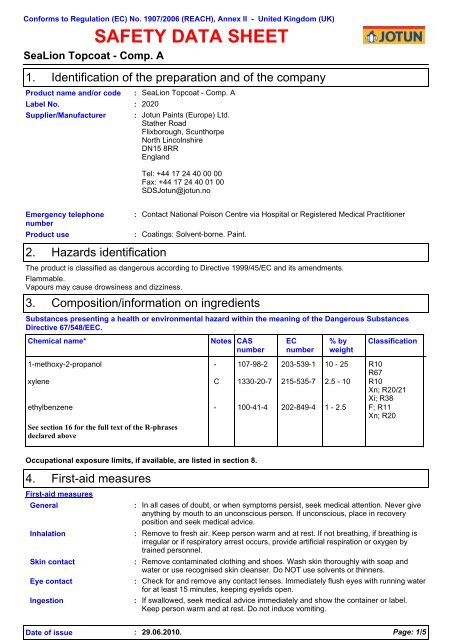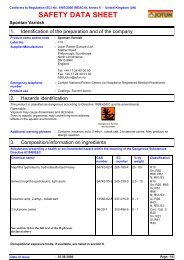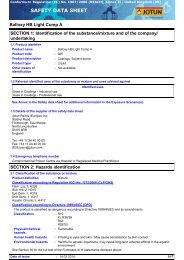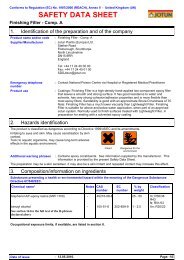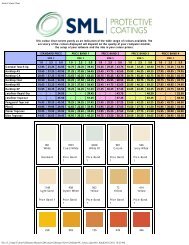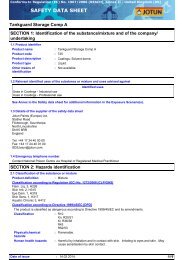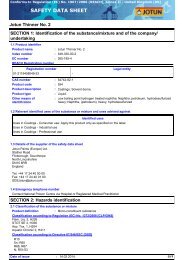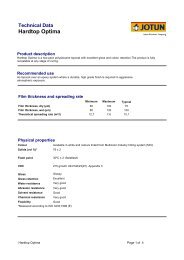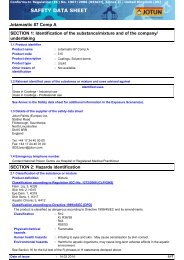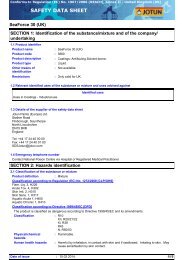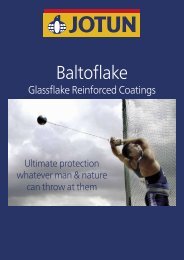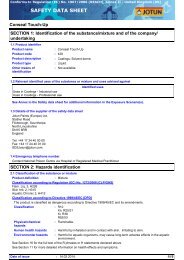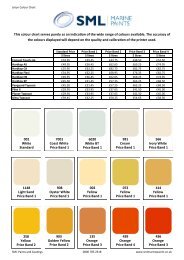SAFETY DATA SHEET - SML Marine Paints
SAFETY DATA SHEET - SML Marine Paints
SAFETY DATA SHEET - SML Marine Paints
Create successful ePaper yourself
Turn your PDF publications into a flip-book with our unique Google optimized e-Paper software.
Conforms to Regulation (EC) No. 1907/2006 (REACH), Annex II - United Kingdom (UK)<strong>SAFETY</strong> <strong>DATA</strong> <strong>SHEET</strong>SeaLion Topcoat - Comp. A1.Identification of the preparation and of the companyProduct name and/or code :SeaLion Topcoat - Comp. ALabel No. : 2020Supplier/Manufacturer : Jotun <strong>Paints</strong> (Europe) Ltd.Stather RoadFlixborough, ScunthorpeNorth LincolnshireDN15 8RREnglandTel: +44 17 24 40 00 00Fax: +44 17 24 40 01 00SDSJotun@jotun.noEmergency telephonenumberProduct use::Contact National Poison Centre via Hospital or Registered Medical PractitionerCoatings: Solvent-borne. Paint.2.Hazards identificationThe product is classified as dangerous according to Directive 1999/45/EC and its amendments.Flammable.Vapours may cause drowsiness and dizziness.3.Composition/information on ingredientsSubstances presenting a health or environmental hazard within the meaning of the Dangerous SubstancesDirective 67/548/EEC.Chemical name*NotesCASnumberECnumber% byweightClassification1-methoxy-2-propanol - 107-98-2 203-539-1 10 - 25 R10R67xylene C 1330-20-7 215-535-7 2.5 - 10 R10Xn; R20/21Xi; R38ethylbenzene - 100-41-4 202-849-4 1 - 2.5 F; R11Xn; R20See section 16 for the full text of the R-phrasesdeclared aboveOccupational exposure limits, if available, are listed in section 8.4.First-aid measuresFirst-aid measuresGeneralInhalationSkin contactEye contactIngestion:::::In all cases of doubt, or when symptoms persist, seek medical attention. Never giveanything by mouth to an unconscious person. If unconscious, place in recoveryposition and seek medical advice.Remove to fresh air. Keep person warm and at rest. If not breathing, if breathing isirregular or if respiratory arrest occurs, provide artificial respiration or oxygen bytrained personnel.Remove contaminated clothing and shoes. Wash skin thoroughly with soap andwater or use recognised skin cleanser. Do NOT use solvents or thinners.Check for and remove any contact lenses. Immediately flush eyes with running waterfor at least 15 minutes, keeping eyelids open.If swallowed, seek medical advice immediately and show the container or label.Keep person warm and at rest. Do not induce vomiting.Date of issue : 29.06.2010.Page: 1/5
SeaLion Topcoat - Comp. AIngredient name1-methoxy-2-propanolxyleneethylbenzeneOccupational exposure limitsEH40/2005 WELs (United Kingdom (UK), 8/2007). Absorbedthrough skin.STEL: 560 mg/m³ 15 minute(s).STEL: 150 ppm 15 minute(s).TWA: 375 mg/m³ 8 hour(s).TWA: 100 ppm 8 hour(s).EH40/2005 WELs (United Kingdom (UK), 8/2007). Absorbedthrough skin.STEL: 441 mg/m³ 15 minute(s).STEL: 100 ppm 15 minute(s).TWA: 220 mg/m³ 8 hour(s).TWA: 50 ppm 8 hour(s).EH40/2005 WELs (United Kingdom (UK), 8/2007). Absorbedthrough skin.STEL: 552 mg/m³ 15 minute(s).STEL: 125 ppm 15 minute(s).TWA: 100 ppm 8 hour(s).TWA: 441 mg/m³ 8 hour(s).Personal protective equipmentRespiratory system :Skin and body:Hands:If workers are exposed to concentrations above the exposure limit, they must useappropriate, certified respirators. Use respiratory mask with charcoal and dust filterwhen spraying this product.(as filter combination A2-P2). In confined spaces, usecompressed-air or fresh-air respiratory equipment. When use of roller or brush,consider use of charcoalfilter.Personnel should wear antistatic clothing made of natural fibres or of hightemperature-resistantsynthetic fibres.Wear suitable gloves.Eyes9.:Recommended, gloves(breakthrough time) > 8 hours: nitrile rubber, 4H, TeflonMay be used, gloves(breakthrough time) 4 - 8 hours: neoprene, butyl rubberNot recommended, gloves(breakthrough time) < 1 hour: PVCFor right choice of glove materials, with focus on chemical resistance and time ofpenetration, seek advice by the supplier of chemical resistant gloves.The user must check that the final choice of type of glove selected for handling thisproduct is the most appropriate and takes into account the particular conditions ofuse, as included in the user's risk assessment.Physical and chemical propertiesPhysical state: Liquid.Odour: Characteristic.Colour: Various colours.Flash point: Closed cup: 27°C (80,6°F)Density : 0.99 g/cm 3Use safety eyewear designed to protect against splash of liquids.Explosion limits : 1.1 - 13.7%Solubility: Insoluble in the following materials: cold water and hot water.10.Stability and reactivityStable under recommended storage and handling conditions (see section 7).Hazardous decomposition products: carbon monoxide, carbon dioxide, smoke, oxides of nitrogen.Keep away from the following materials to prevent strong exothermic reactions: oxidising agents, strong alkalis, strongacids.Date of issue : 29.06.2010.Page: 3/5
SeaLion Topcoat - Comp. A11.Toxicological informationThere is no data available on the preparation itself. The preparation has been assessed following the conventionalmethod of the Dangerous Preparations Directive 1999/45/EC and classified for toxicological hazards accordingly. Seesections 2 and 15 for details.Exposure to component solvent vapour concentrations in excess of the stated occupational exposure limit may result inadverse health effects such as mucous membrane and respiratory system irritation and adverse effects on the kidneys,liver and central nervous system. Solvents may cause some of the above effects by absorption through the skin.Symptoms and signs include headache, dizziness, fatigue, muscular weakness, drowsiness and, in extreme cases, lossof consciousness. Repeated or prolonged contact with the preparation may cause removal of natural fat from the skin,resulting in non-allergic contact dermatitis and absorption through the skin. If splashed in the eyes, the liquid may causeirritation and reversible damage. Swallowing may cause nausea, diarrhoea, vomiting, gastro-intestinal irritation andchemical pneumonia.12.Ecological informationThere is no data available on the preparation itself.Do not allow to enter drains or watercourses.The preparation has been assessed following the conventional method of the Dangerous Preparations Directive1999/45/EC and is not classified as dangerous for the environment.Aquatic ecotoxicityProduct/ingredient name Test ResultSpecies Exposurexylene Mortality Acute LC50 12000 to Fish - Bluegill 96 hours16114 ug/L Fresh water - Lepomismacrochirus -1,1 gethylbenzene Population Acute EC50 7,2 mg/L Algae 48 hoursIntoxication Acute EC50 2,93 mg/L Daphnia 48 hoursMortality Acute LC50 4,2 mg/L Fish 96 hoursEcological informationBiodegradabilityProduct/ingredient name Aquatic half-life Photolysis Biodegradabilityxylene - - ReadilyBioaccumulative potentialProduct/ingredient nameLogKow BCF Potentialxylene 3,12 - high13.Disposal considerationsDo not allow to enter drains or watercourses. Material and/or container must be disposed of as hazardous waste.European waste catalogue(EWC)14.Transport informationInternational transport regulationsProper shipping nameUN Number::Paint1263Class : 3Packing group: IIILabel::08 01 11* waste paint and varnish containing organic solvents or other dangeroussubstances. If this product is mixed with other wastes, this code may no longer apply.If mixed with other wastes, the appropriate code should be assigned. For furtherinformation, contact your local waste authority.Transport within user’s premises: always transport in closed containers that are upright and secure. Ensure thatpersons transporting the product know what to do in the event of an accident or spillage.Additional informationDate of issue : 29.06.2010.Page: 4/5


